Functioning DNA nanorobots to deliver specific molecular signals to cells were designed by combining DNA origami, DNA aptamers, and DNA logic gates.
DNA nanotechnology-based nanorobot delivers cell suicide message to cancer cells


Functioning DNA nanorobots to deliver specific molecular signals to cells were designed by combining DNA origami, DNA aptamers, and DNA logic gates.
A talk at TEDxBerkeley includes nanotechnology among the options for digital fabrication, one of five new rules of innovation.

New computational methods to explore the rapidly expanding collection of high resolution three-dimensional RNA structures reveal new RNA structural motifs, identifying additional building blocks for complex RNA nanostructures.
A set of machine learning programs can now predict properties of small organic molecules as accurately as can calculations based upon the Schrödinger equation, but in milliseconds rather than hours.
Researchers in Australia and the US have demonstrated a working transistor by placing of single atom of phosphorous with atomic precision between gates made of wires only a few phosphorous atoms wide. This demonstration points to possibly extending current computer technology to the atomic scale.

Scientists at Kyoto University and the University of Oxford have combined DNA origami and DNA motors to take another step toward programmed artificial molecular assembly lines.
Foldit game players have again out-performed scientists in protein design, this time improving the design of a protein designed from scratch to catalyze Diels-Alder cycloadditions.
Human life after advanced nanotechnology has been developed will be fundamentally different from life up until that point.
An array of 96 iron atoms on a copper nitride surface, assembled using an STM and used to write a byte, demonstrates how small magnetic storage could shrink and may lead to novel nanomaterials for quantum computers.
An article in The Guardian quotes Christine Peterson and Robert Freitas on the vision of molecular manufacturing. Freitas is quoted as expecting that the development of nanofactories could be done in 20 years for “on the order of” one billion dollars.